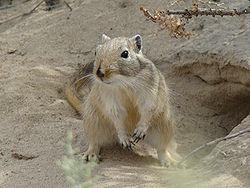Ecology and behavior
Great gerbils live in family groups and occupy one burrow per family. [3] Their burrows can be fairly extensive with separate chambers for nests and food storage. Great gerbils spend considerably more time in the burrows during winter, but do not hibernate. They are predominantly diurnal. Food consists mostly of vegetable matter. [2]
The animals are often colonial. Longevity is 2–4 years. Burrow system complexes have a distinctive region of cleared soil and can be seen and mapped from aerial photos and satellite images. [4] Inhabited great gerbil burrows can be distinguished from abandoned burrows using satellite images. [5]
Great gerbils are known reservoirs of Yersinia pestis , the bacterium that causes plague, and of Leishmania major , the causative agent of zoonotic cutaneous leishmaniasis. They are also known as crop pests and have been implicated in exacerbating erosion.
This page is based on this
Wikipedia article Text is available under the
CC BY-SA 4.0 license; additional terms may apply.
Images, videos and audio are available under their respective licenses.









